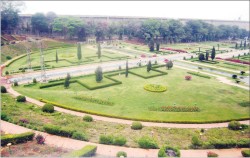Krumbiegal was a landscape designer who designed the Brindavan Gardens, Lal Bagh, Chamundi Gymkhana…
by S.N. Venkatnag Sobers
We have come across many incidents in the past where foreigners have visited India in search of their roots or to know more about their relatives who lived in India for a long time. Many of them have also visited India for research work, especially from England, as ours was a British Colony.
Mysore city recently had one such visitor from Dresden, Germany, who had come here to study the works done by Gustav Hermann Krumbiegal, a German Botanist and garden designer, who is known for his works at the Lal Bagh Botanical Gardens, Bangalore and for the planning of the avenues of Bangalore.
Dr. Anja Eppert, Garden Superintendent, Dresden, was in Mysore to study the works of Krumbiegal. She visited Brindavan Gardens, Chamundi Gymkhana inside Mysore Race Club premises, Mysore Palace, Fernhills Palace, Ooty, which are said to be designed by Krumbiegal during his stay in Mysore.
Her visit has gained prominence as the German Authorities in Dresden have decided to celebrate the 150th anniversary of Krumbiegal and also introduce him to Germans as majority of them do not know much about him.
Speaking to Star of Mysore, Dr. Anja said that some of the gardens designed by Krumbiegal have not been well-maintained. “In case of buildings, it is a different as they get older and sometimes have to be demolished and reconstructed. But, in case of gardens they have to be maintained well throughout. Gardens tell us stories about the kind of people who lived at the time when it was created. It is very important to tell people about the historical relevance of the parks,” she opined.
Dr. Anja added that the German authorities had taken up the research works of Krumbiegal and had sent her on a visit Mysore, Bangalore and Ooty. She mentioned that the German Counselor General in Bangalore informed the authorities about the works done by Krumbiegal during his stay here and that is when they decided to organise an exhibition on Krumbiegal works.
The exhibition will be held next year at Pillinitz Castle and Park in Germany. The German authorities have also planned to publish a book on Krumbiegal. Dr. Anja said that a similar exhibition is also being planned in Bangalore as it would be a good opportunity to exchange garden culture among the two countries.
During her visit to Mysore and Bangalore, Dr. Anja was accompanied by Prasanna Kumar, Retd. Deputy Director of Horticulture, who was in-charge of gardens in Mysore, especially at Lalitha Mahal and had knowledge on Krumbiegal’s works.
For those who do not know about Krumbiegal, he was born in Lohmen near Dresden, and his early studies were in Wilsdruff and Dresden after which he trained in horticulture. In 1884, he worked in Schwerin and from 1885 to 1887 he worked as a landscape gardener in Hamburg. In 1888, he moved to England, designing flower beds at the Hyde Park and became a staff at the Royal Botanical Gardens in Kew. He then took up a position in 1893 with the Princely State of Baroda as Curator of the botanical gardens there. He also worked with the Government Botanical Gardens at Ootacamund and was responsible for redesigning the architecture. In 1908, he was requested by Krishnaraja Wadiyar, the then Mysore ruler, to serve him and he succeeded John Cameron at the Lal Bagh Gardens as an economic botanist and superintendent.
Krumbiegal introduced numerous plants and was involved in designing the landscape for Brindavan Gardens in KRS. He was also actively involved with the Mysore Horticultural Society that was started in 1912. He obtained seeds from other countries and sent collections in return to Kew and USA. These included Indian specialties such as bamboo rice, varieties of other rice, mango and others.
Outside his key work area, he was often involved in architectural design. The Dewan of Mysore appointed him as an architectural consultant despite protests from the British Resident in Mysore. During the Second World War, Germans in India were declared as enemies and Krumbiegal was along with other Germans kept in an internment camp in Bangalore.
Krumbiegal was responsible for the introduction of many ornamental plants and flowering trees. He was also involved in the choice of avenue trees for Bangalore. The road adjoining Lal Bagh is named after him as ‘Krumbiegal Road’.
source: http://www.starofmysore.com / Star of Mysore / Home> Feature Articles / March 21st, 2014
